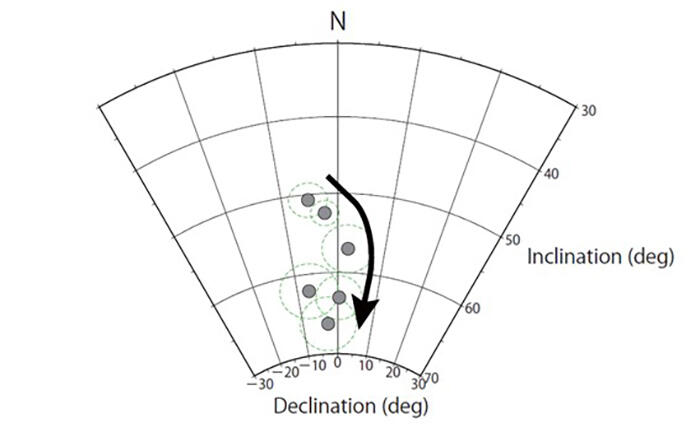A research group with members from Kumamoto University, Ibaraki University, Kochi University, Hokkaido University, and Doshisha University has successfully reconstructed the paleomagnetic direction using the strata of overlapping pyroclastic flows deposited from the Shikotsu caldera eruption that occurred about 45,000 years ago in Hokkaido. The group also used the paleomagnetic direction to estimate that the eruption continued for several hundred years.

Provided by Kumamoto University
Eruptions that form giant calderas (super-eruptions) are infrequent, occurring only once every 10,000 years, but their impact as disasters is catastrophic. However, there are few ways to determine the duration of prior super-eruptions, and geology has long viewed them as fleeting phenomena.
Pyroclastic deposits from the Shikotsu caldera eruption (which had an eruptive volume of >100 cubic kilometers) had been divided into six units in previous studies, with two dormancy periods noted. The research group investigated the duration of the eruption by reconstructing variations in the paleomagnetic direction at that time from the continuous strata of pyroclastic deposits from the Shikotsu caldera eruption.
The group developed a special apparatus for collecting oriented samples of non-welded pyroclastic flow deposits, which had previously been considered difficult to gather. From this, they succeeded in collecting oriented samples with smaller errors than previous methods. As a result, the group was able to reconstruct the paleomagnetic direction from the overlaying non-welded pyroclastic flow deposit strata created by the Shikotsu caldera eruption. They confirmed a variation in direction of about 15 degrees. By comparing this finding to the rate of variation in general paleomagnetic direction (several degrees per century), they were able to estimate that the Shikotsu caldera eruption continued for several hundred years.
Associate Professor Nobutatsu Mochizuki of the Faculty of Advanced Science and Technology, Kumamoto University, commented, "This improved method of collecting directional samples from pyroclastic flow deposits in powder form has enabled us to obtain better quality data than before. We would like to contribute to the study of volcanic eruptions by widely applying our approach to pyroclastic flow deposits and lava, to estimate the time scale of the eruption process."
■ Paleomagnetic direction: Past geomagnetic orientation reconstructed from volcanic rocks and sediment. Data from the past 1,600 years shows that this direction has fluctuated at an average rate of several degrees per century.
This article has been translated by JST with permission from The Science News Ltd.(https://sci-news.co.jp/). Unauthorized reproduction of the article and photographs is prohibited.




